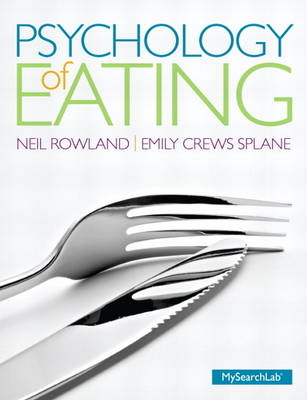
Psychology of Eating
Pearson (Verlag)
978-0-205-85263-5 (ISBN)
- Titel ist leider vergriffen;
keine Neuauflage - Artikel merken
Packages
Access codes for Pearson's MyLab & Mastering products may not be included when purchasing or renting from companies other than Pearson; check with the seller before completing your purchase.
Used or rental books
If you rent or purchase a used book with an access code, the access code may have been redeemed previously and you may have to purchase a new access code.
Access codes
Access codes that are purchased from sellers other than Pearson carry a higher risk of being either the wrong ISBN or a previously redeemed code. Check with the seller prior to purchase.
-- Examines the biological, psychological, and sociocultural influences on eating behaviors
Psychology of Eating provides a multi-disciplinary overview to the study of eating; it examines current research in biology, nutrition, psychology, and more. The text’s balance of major theories, historical and current research, and real-life examples enables students to understand and interact with the material presented.
In this Section:
1. Brief Table of Contents
2. Full Table of Contents
Brief Table of Contents
Chapter 1: Psychology of eating: the nexus of nutrition, brain, and behavior
Chapter 2: Macronutrients and the food we eat
Chapter 3: The chemical senses
Chapter 4: You are what you eat: evolution, energy, and foraging
Chapter 5: Basic learning processes and eating behavior
Chapter 6: The development of eating behaviors
Chapter 7: Social influences on eating
Chapter 8: Mood, cravings, and addiction
Chapter 9: Hunger, satiety, and the brain
Chapter 10: Eating disorders and treatment
Chapter 11: Genes, epigenetics, and obesity
Chapter 12: Treatments for obesity
Chapter 13: Where do we go from here?
Full Table of Contents
Chapter 1: Psychology of eating: the nexus of nutrition, brain, and behavior
Introduction
What Is the Goal of Eating?
What Is the Definition of Obesity?
Biomedical or Environmental or Both?
Chapter 2: Macronutrients and the food we eat
Macronutrient Classes
Micronutrients
Energy Balance
Chapter 3: The chemical senses
Olfaction: The Sense of Smell
Gustation: The Sense of Taste
Taste or Flavor Guided Behaviors
Chemical Sensing and the Enteric Nervous System
Gut Hormones That Affect Food Intake
Chapter 4: You are what you eat: evolution, energy, and foraging
Ancestors and Evolution
Energy
Optimal Foraging
Economics of Food
Portion Size
Concluding Remarks
Chapter 5: Basic learning processes and eating behavior
Overview of Classical Conditioning and Terminology
Learning of Post-Ingestive Consequences: Taste Aversions and Preferences
Learning of Food by Experience: Increasing Preferences
Learning of Appropriate Food Quantity: Conditioned Satiety
Learning of When to Eat: Conditioned Hunger
Chapter 6: The development of eating behaviors
The Ontogeny of Human Feeding: Prenatal Experience
Early Postnatal Eating: From Suckling to Eating Solid Foods
Not Needing a Bottle, but Still Needing Guidance: Eating in Early Childhood
External Influences on Children’s Eating: Disruptions in Energy Self-Regulation
Implications for Instilling Healthy Eating Habits in Children
Chapter 7: Social influences on eating
Cuisine
Direct versus Indirect Influences
Food Associations with the Provider
Conclusion
Chapter 8: Mood, cravings, and addiction
The Mood-Food Connection
Food Cravings
Can Someone Actually be a “Food Addict”?
Concluding Remarks
Chapter 9: Hunger, satiety, and the brain
Central Origin of Hunger
Allostasis
Hypothalamus, Transmitters, and Feeding
Reward and Decision Making
Chapter 10: Eating disorders and treatment
Anorexia Nervosa
Bulimia Nervosa
Risk Factors for Eating Disorders
Biopsychosocial Explanations of Eating Disorders
Treatments
Animal Models of Anorexia and Bulimia
Conclusion
Chapter 11: Genes, epigenetics, and obesity
Introduction
Monogenic Obesity
Polygenic Obesity
Epigenetics and Developmental Programming
Dietary Obesity
Chapter 12: Treatments for obesity
Anti-Obesity Drugs
Calorie Substitutes
Surgery for Obesity (Bariatric Surgery)
Diet, Exercise, and Behavioral Therapy
Conclusion
Chapter 13: Where do we go from here?
Anti-Obesity Drugs
Calorie Substitutes
Surgery for Obesity (Bariatric Surgery)
Diet, Exercise, and Behavioral Therapy
Conclusion
| Erscheint lt. Verlag | 10.2.2014 |
|---|---|
| Sprache | englisch |
| Maße | 180 x 230 mm |
| Gewicht | 296 g |
| Themenwelt | Schulbuch / Wörterbuch |
| Geisteswissenschaften ► Psychologie ► Biopsychologie / Neurowissenschaften | |
| Geisteswissenschaften ► Psychologie ► Persönlichkeitsstörungen | |
| Medizin / Pharmazie ► Gesundheitsfachberufe ► Diätassistenz / Ernährungsberatung | |
| ISBN-10 | 0-205-85263-7 / 0205852637 |
| ISBN-13 | 978-0-205-85263-5 / 9780205852635 |
| Zustand | Neuware |
| Haben Sie eine Frage zum Produkt? |
aus dem Bereich


